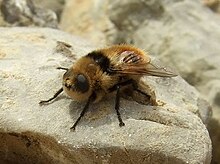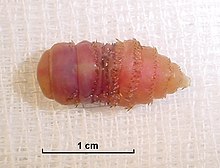Botfly
| Botfly | |
|---|---|

| |
| Deer botfly Cephenemyia stimulator
| |
| Scientific classification | |
| Domain: | Eukaryota |
| Kingdom: | Animalia |
| Phylum: | Arthropoda |
| Class: | Insecta |
| Order: | Diptera |
| (unranked): | Eremoneura |
| (unranked): | Cyclorrhapha |
| Section: | Schizophora |
| Subsection: | Calyptratae |
| Superfamily: | Oestroidea |
| Family: | Oestridae Leach, 1815 |
| Subfamilies | |
Botflies, also known as warble flies, heel flies, and gadflies, are a family of
General
A botfly,
The word "bot" in this sense means a maggot.[4] A warble is a skin lump or callus such as might be caused by an ill-fitting harness, or by the presence of a warble fly maggot under the skin. The human botfly, Dermatobia hominis, is the only species of botfly whose larvae ordinarily parasitise humans, though flies in some other families episodically cause human myiasis and are sometimes more harmful.
Family Oestridae
The Oestridae now are generally defined as including the former families Oestridae, Cuterebridae, Gasterophilidae, and Hypodermatidae as subfamilies.
The Oestridae, in turn, are a family within the superfamily
Of families of flies causing myiasis, the Oestridae include the highest proportion of species whose larvae live as obligate
Most other species of flies implicated in myiasis are members of related families, such as blow-flies.Infestation

Botflies deposit eggs on a host, or sometimes use an intermediate vector such as the common housefly, mosquitoes, and, in the case of D. hominis, a species of tick. After mating, the female botfly captures the phoretic insect by holding onto its wings with her legs. She then makes the slip—attaching 15 to 30 eggs onto the insect or arachnid's abdomen, where they incubate. The fertilized female does this over and over again to distribute the 100 to 400 eggs she produces in her short adult stage of life of only 8–9 days. Larvae from these eggs, stimulated by the warmth and proximity of a large mammal host, drop onto its skin and burrow underneath.[6] Intermediate vectors are often used, since a number of animal hosts recognize the approach of a botfly and flee.[7]
Eggs are deposited on larger animals'
Myiasis can be caused by larvae burrowing into the skin (or tissue lining) of the host animal. Mature larvae drop from the host and complete the pupal stage in soil. They do not kill the host animal, thus they are true parasites.
The equine botflies present seasonal difficulties to
In cattle, the lesions caused by these flies can become infected by
Philornis botflies often infest nestlings of wild parrots, like scarlet macaws[11] and hyacinth macaws.[12] A method using a reverse syringe design snake bite extractor proved to be suitable for removing larvae from the skin.[11]
Cuterebra fontinella, the mouse botfly, parasitizes small mammals all around North America.[13]
Dermatobia hominis, the human botfly, occasionally uses humans to host its larvae.[14]
As human food

In cold climates supporting
The sixth episode of season one of the television series Beyond Survival, titled "The Inuit – Survivors of the Future", features survival expert Les Stroud and two Inuit guides hunting caribou on the northern coast of Baffin Island near Pond Inlet, Nunavut, Canada. Upon skinning and butchering of one of the animals, numerous larvae (presumably H. tarandi, although not explicitly stated) are apparent on the inside of the caribou pelt. Stroud and his two Inuit guides eat (albeit somewhat reluctantly) one larva each, with Stroud commenting that the larva "tastes like milk" and was historically commonly consumed by the Inuit.[16]
Copious art dating back to the Pleistocene in Europe confirms their consumption in premodern times, as well.[17]
The
See also
- screwworm
- Cordylobia anthropophaga, the tumbu fly
- Philornis, a genus of flies that are subcutaneous parasites of birds, sometimes referred to as "bot flies"
References
- ISBN 978-1-59695-114-3.
- ISBN 978-0-12-372500-4.
- ^ Journal of the Department of Agriculture of Western Australia, Volume 9, Pub: Western Australia. Dept. of Agriculture, 1904, p 17
- ^ ISBN 0-19-861271-0.
- S2CID 83936667.
- ^ Dunleavy, Stephen (producer) (2005-10-20). Life In The Undergrowth: Intimate Relations (Programme synopses). BBC. Retrieved 2008-12-17.
- ^ Drees B, Jackman J (1999). "Horse Bot Fly". Field Guide to Texas Insects. Houston, Texas: Gulf Publishing Company. Archived from the original on 2012-11-14. Retrieved 12 June 2013.
- ^ a b Ondrak J. "Ask The Vet: Treating Bot Infestations In Horses". lambriarvet.com. Archived from the original on 2009-08-22. Retrieved 2009-09-10.
- OCLC 191846476. Retrieved 2009-02-13.
- S2CID 19888515.
- ^ PMID 23384580.
- S2CID 22897475.
- ^
Jennison CA, Rodas LR, Barrett GW (2006). "Cuterebra fontinella parasitism on Peromyscus leucopus and Ochrotomys nuttalli". Southeastern Naturalist. 5 (1): 157–168. S2CID 87286185.
- ^ "Human Bot Fly Myiasis" (PDF). U.S. Army Public Health Command (provisional), formerly U.S. Army Center for Health Promotion and Preventive Medicine. January 2010. Retrieved 2014-08-14.
- ^ Felt E (1918). "Caribou warble grubs edible". Journal of Economic Entomology. 11: 482.
- ^ "Les Stroud Beyond Survival: The Inuit – Survivors of the Future". Lesstroud.ca. Archived from the original on 2016-03-02. Retrieved 2015-11-10.
- ISBN 978-0-226-31126-5. Retrieved 7 May 2013.
- ^ "Chullin 67b:11". www.sefaria.org. Retrieved 2021-01-02.
